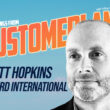iSeatz 2024 Loyalty Trends Report: What consumers value most in their loyalty program is saving money on travel.
For the past two years, American consumers have grappled with persistent inflation, high (and rising) prices, and increased demand for travel. Is it any surprise that identifying and receiving value is their top priority for the loyalty programs to which they belong?
by Kenneth Purcell
This was the overwhelming finding from our recent report, 2024 Loyalty Trends: The Role of Travel Loyalty Programs in the New Value Economy, the latest in our Tipping Point series. It’s based on a survey of 2,116 U.S. consumers, 49% of whom say what they value most in their loyalty program is saving money on travel. Value also dictates how frequently consumers interact with their loyalty programs – 65% say they would engage more with their loyalty programs if they offered better discounts.
This data shows consumers increasingly look to their loyalty programs to save money and provide the value they can’t get from other brands or programs. But discounts and monetary incentives aren’t the only way travel loyalty programs can deliver value.
The Value of Experience
If “deals” and savings still largely determine how frequently consumers choose to use their loyalty programs, the perceived quality of rewards and the ability to use or earn points drives their decision to spend more. For example, 29% of the Millennials we surveyed said they would spend up to 5% more on travel to preserve their status or receive bonus benefits, and 26% of Gen Zers would spend between 6% and 10% more.
This suggests that travel loyalty programs (and their parent brands) can increase spending and engagement by providing a better loyalty experience that unlocks value for members.
Evolving Brand Priorities
This focus on boosting engagement through an improved loyalty experience dovetails with what brands reported as their key priorities for their loyalty programs this year. Our report also contains data from a concurrent survey of 151 loyalty program managers in the US, 66% of whom cited customer retention as the top metric used to measure the success of their programs. But that was closely followed by the 65% of loyalty professionals who said that impact on revenue was their top KPI, reflecting a stronger focus on delivering financial results.
What are travel loyalty programs doing to achieve those results? First, they’re identifying and targeting higher-spending, luxury-oriented bookers, members, and purchasers, moving away from approaches designed to appeal to the general public. In our January 2023 Tipping Point report, for example, 44% of surveyed brands said that their loyalty programs’ primary target was the general public; in 2023, that percentage dropped to 23%, while the percentage of brands targeting luxury audiences increased from 11% to 23%.
Investing in Fintech and Sustainability
At the same time, travel loyalty professionals are investing in technology that makes travel more attainable and secure for all member segments. As 73% of consumers say that the availability of more fintech tools would increase the likelihood of booking travel with their loyalty program (up from 68% in 2022), loyalty programs are responding by investing in capabilities like price or fare freezing, something 28% of brands plan to adopt in the next 6-12 months.
Similarly, consumers are eager for more sustainability-related options in their loyalty programs, with 55% going so far as to say that they would choose one loyalty program over another if it prioritized sustainability. This is perhaps why 60% of the surveyed brands plan to invest more in sustainable redemption options over the next year. Our data suggests this will pay off for them: 60% of brands saw reduced churn and increased retention after implementing sustainability initiatives.
Creating a Value-Driving Loyalty Experience
Value-oriented consumers are increasingly turning to their loyalty programs to make travel more affordable. To get the most out of this behavior – and to meet their goals of retention and revenue generation – loyalty programs are investing in fintech tools and sustainability initiatives, and generally trying to create a more compelling experience for their members. Brands prioritizing a positive loyalty program experience to drive membership engagement will be best positioned to capitalize on the prevailing travel and loyalty trends in the marketplace.
Kenneth Purcell is the Founder & CEO of iSeatz, a leading provider of travel loyalty technology and digital commerce solutions that celebrates its 25th anniversary this year. Kenneth has extensive expertise and experience in the travel industry and was one of the early pioneers of airline ancillaries in the U.S. Under his leadership, iSeatz has grown into one of the world’s premier integrated platform providers, connecting major hospitality, airline, and financial services brands with a suite of travel and lifestyle products that drive customer loyalty, engagement, and lifetime value.
Photo by Tom Barrett on Unsplash













